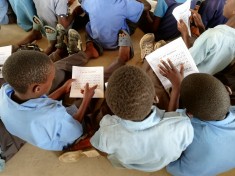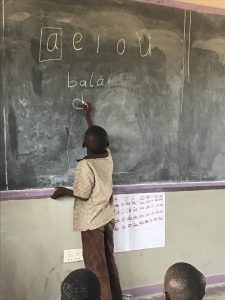
This blogpost is authored by Rukmini Banerji (CEO, Pratham; second from right in the photo above). In January, she visited Zambia with the TaRL Africa Board of Directors to see the Catch Up programme in action and shares snapshots and her reflections.
The teacher was telling a story. It was a story from her own childhood; about a morning when she overslept and missed the right time to go to school and the adventures that followed as she tried to rush to get there. Children sat around in a circle listening to her. With eyes wide open, they intently followed her voice and her gestures. Outside, the warm afternoon breeze blew through the trees and over the red soil. We were in Kazungula district, not far from the Zambezi river in the southern province of Zambia.
This was a “Catch Up” class in a primary school. In Zambia, the Ministry of Basic Education is running a programme to help children in Grades 3, 4 and 5 who have not yet learned to read or are struggling with basic arithmetic. Based on an approach called Teaching at the Right Level developed originally in India by Pratham, the foundational literacy-numeracy “Catch Up” initiative is being implemented by government schoolteachers in the Eastern and Southern provinces of Zambia. Children across the three grades are grouped by their current learning levels rather than by their grade. Teachers worked with the different groups using a variety of games and activities that have been systematically designed to enable children to become fluent readers and confident with basic arithmetic skills. Children work in big groups, then break into smaller groups to practice and often do quick individual activities as well. These combined activities seem to help them progress quickly. Soon, they move into the next group, and the next group, until almost everyone is in the top-most group.
We were with a group of children who could read words and were now learning to read sentences. The teacher had finished her story and moved on to the next activity. Now every child had a short text in front of them. The teacher read the paragraph out aloud. Children followed, their fingers moving in the book from one word to the next as she read. Soon, children were sounding out words. Some took their time; some could read more fluently. But everyone was making progress slowly or quickly from words to sentences to short paragraphs.

The District Education Board Secretary of Kazungula took us through the district’s journey (Kazungula is one of the 27 districts in Zambia implementing Catch Up). In 2018, 20 schools in Kazungula district participated in Catch Up. The results were promising. In 2019, 75 additional schools joined the programme. The results not only remained good but actually got better. In Kazungula, the percentage of children reading fluently moved from 31 percent at baseline to 51 percent by endline. Similar improvements in arithmetic were visible as well. The assistant District Resource Centre Coordinator looked into his notebook. “In the baseline in 2019, we had 3,766 children who could not even read letters. By midline this number was at 1,672 and by endline there were about 1,000 children left in this category.” “The terrain is tough, the district is understaffed, villages are remote and hard to reach, transport is difficult,” explained the District Secretary, “but we are still making progress.”
“What is the secret of this progress?” we asked. “What is happening now that was not happening before?” The district government team offered many thoughts: “the training had many people in a group and so perhaps they did not all get the entire approach. Visiting schools after training we could see the gaps so retraining sessions were done in smaller groups, zones clustered together,” said the assistant District Resource Centre Coordinator. The District Secretary felt that “if you get the basics then that is foundation of education.” Finding time to focus on core foundational skills was essential. Another district officer pointed to motivation – “the Secretary comes to each training to speak directly to the teachers.” Something is happening all the time, communication goes out to schools, time is important, mentorship is important.
The district coordinator from VVOB - education for development, the organisation supporting the programme in this and other districts, pointed to the fact that “all master trainers conducted 20 days of practice themselves and tasted success from seeing how their children progressed. Once this happened helping and inspiring teachers was easy”.
The teacher wrote a sentence on the blackboard. She turned to the class and asked them to read it. One child read the words loudly. Others laughed as they listened. The sentence was not correct. So, now what needs to be done? The sentence needs to be fixed. One boy went up to the blackboard and rearranged the words so that the sentence read correctly. The teacher wrote another sentence … again the children jumped up and down raising their hands. They love correcting mistakes. Don’t forget, these are children who can read words and are just learning to read sentences. Yes, they have a lot to say. The teacher stood back. She has a shy smile, but it was a proud and victorious smile. Her children were well on their way to success.

We are back in the district office. The District Secretary welcomes us back warmly. He tells us of a review meeting towards the end of last year where progress of children in all districts was discussed. “We were left smiling,” he says. “Kazungula was right up there.” Now his voice drops dramatically, “we have to strive to remain up there.”
This is a beginning. There is still a lot of work to be done. Change is possible. Very possible. There is instant feedback from the children. Things are happening all the time. Confidence and capability are building day by day. In the class, in the school and at the district level, the goal is clear. The basic foundations have to be built and then there is no end to what children will be able to do. “What about the thousand children who are still at beginner level?” The district team members smile. Just like the teacher in the school, their smiles are warm, confident and determined. One of them replies. “At the soonest!!!”
Rukmini Banerji

Dr. Rukmini Banerji is CEO of Pratham, where she has been part of the leadership team since 1996. Since 2005, she has led the Annual Status of Education Report (ASER). In 2008 Rukmini was the inaugural recipient of the Maulana Abul Kalam Shiksha Puraskar Award conferred by the Government of Bihar, India. She is internationally recognised as a champion and expert of foundational learning.




